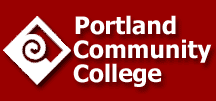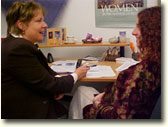 |
 |
||
| CIS/CAS/CS |

Traditional Resume :: GuidelinesDevelop a resume that you will feel confident sending to potential employers. The true test of a good resume is whether it produces interviews. When developing your resume you may need to produce one style to be read and another to be scanned for a database. These styles are very different in both layout and content. We will cover both types in this course. DEVELOPING A TRADITIONAL RESUME ::Purpose Your resume is a marketing tool to obtain an interview. The reader of your resume needs to envision you as a professional. Do not showcase yourself as a student by listing course work or highlighting unrelated skills from your previous career. The ideal resume is one that outlines technical skills, knowledge and experience which matches the labor market requirements in the career you are pursuing. When developing your resume each line must convince the employer to contact you. Do not have potential employers review information that may distract them from the task of finding you to be the perfect employee for their job. Think of your resume as your work search marketing brochure. It does not have to be a complete work history. You will be asked to provide your work history on the application form. ::Presentation An employer's first impression of you is the presentation of your written materials. It is equally as important as the impression you will make during your interview. Use high quality 60# weight paper and envelopes for all application materials, including resume, cover letter, reference list and follow up correspondence. Single sheets of resume paper and matching envelopes may be purchased at any copy retail store. The overall appearance of your presentation should be professional in your choice of paper color (white, gray or tan) and font selection (Times New Roman, Helvetica). ::Resume Styles: Skill Based vs. Chronological A technical or skill based resume works well if you do not have ample work experience or if your experience is limited in your professional field. By contrast, a chronological work history resume is effective after you have gained substantial work experience in industry. Review sample of Skill Based resume and Chronological resume. ::Layout When developing a resume make it concise and on target. Employers do not want to read information that is not helpful in the selection of a candidate. Remember that employers often review multiple application materials within tight timelines. Many employers do not read full paragraphs or full pages. Develop your resume so that a person can easily read over it. Put the most important information towards the top. Bullets and white space are important in the overall layout design. The use of bullets, bold and italic fonts can be a very effective way to draw the attention of the reader to your most marketable information. ::Length A one-page resume is the ideal. A multiple page resume may be used only if the total content communicates your marketable qualities for the position you are seeking. Every line of your resume must market you for the employment objective. ::Resume Heading A resume heading for the first page should always include your name, address, telephone number(s) and an e-mail address and may include your "Objective". With the use of today's technology, an e-mail address is a necessity. Any additional page(s) should only show your name and page number. When designing the heading for your resume, your name should be prominent. You want it to be remembered. You may use large, bold or creative fonts to accomplish this. ::Objective The use of an employment objective is recommended when developing your resume. An objective must clearly state the position or type of work you are seeking. This can be done as a title in the "Resume Heading" or as the first line of the resume body under an "Objective" category. "Network Assistant" is an example of a title objective and "To secure a position as a network assistant" is an example of an objective under a separate category. Employers will review your objective to determine if it matches their job opening. You should not use an objective to outline what you want the employer to do for you or the kind of company you want to work for. "To secure a position which offers an opportunity for advancement" is an example of an inappropriate request. ::Technical Knowledge An employer will be interested in the specific knowledge you have acquired. These may include topics such as programs, languages, operating systems, hardware, software, networking, and the Internet. You should include all topics with which you are familiar. Students often need to be reminded of how much knowledge they have acquired. You do not need to be an "expert" at everything you list on your resume. However, with the use of source guides and manuals you must be productive in a short period of time. ::Skills and Experience The skills and experience section of a resume must be very powerful. You may include newly acquired skills gained from your course work, transferable skills from your employment history, and/or personal experience outside of school or work that relates to the position you are seeking. Skills sell better than course titles. Do not list classes in any part of your resume. Usually, a course title does not tell the reader what skills or knowledge you have. Focus on class contents and describe projects that relate to the types of positions for which you are applying. When developing this section, first brainstorm a list to answer the question, "what skills and experience will I bring to this position". Then prioritize your list, cluster it into groups and develop appropriate headings. Each skill or experience should be stated as an accomplishment or fact to prove that you possess these qualities. Include web site address(es) that you have created, designed or developed. ::Work History Your resume does not have to include a detailed work history. Decide the aspects of your work experience that will help the employer select you for an interview. There are many options when formatting your work history. Headings may be selected from a variety of possibilities including Professional Skills, Field Experience, Professional Experience or Work Experience. Detail only the duties that portray you as a professional. Include transferable experience in one section and a concise listing of employers in another. Dates should not be used when you have employment gaps. Instead, use number of months or years when indicating your length of employment. Additionally, within the work history section you will want to showcase your interpersonal skills. This is because employers view them as the primary attribute they seek when recruiting new employees. Two examples of this would be to detail your customer service or team project experience. ::Professional Training The term professional training is often used in the business community. It can be to your advantage to use business jargon instead of educational terminology in your correspondence when applying for private sector positions. The heading of Professional Training is more marketable than Education for highlighting non-credit classes and industry sponsored training. ::Education When developing the education portion of your resume you will need to state that you are studying or have earned a certificate or degree. PCC's programs have an excellent reputation in the Portland Metropolitan area. It should be the first listing in the Education Section. Always list the most important information first. Your training related to professional area is often seen as more valuable then even a Bachelors Degree in another subject area. List your Bachelor Degree second unless it is related to the company's primary line of work. Do not include your high school diploma on your resume. This is information you will include on an application form. If you do not intend to earn a degree or have completed a limited number of courses towards your degree, state the program in which you are enrolled. On the other hand, if you are close to earning a degree, include the year you will graduate. Education may be listed near the bottom of the resume. ::References It is very common to see phrases like; "References available upon request" or "References and transcripts gladly provided" on the bottom of a resume. Many advise continuing this practice and others suggest leaving it off completely. A reference statement can be useful to show closure or improve the resume format appearance. The choice of using a reference statement is personal preference. References should not be included in a resume. Please see the Reference Page section of the course.
::Traditional Resume Assignment Develop a traditional resume. Must be completed to be subscribed to the list. View sample resumes.
|